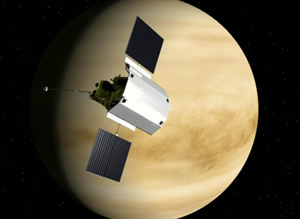
The upcoming flyby of a NASA spacecraft over Venus could provide new insights about the cloud-shrouded planet and will serve as a dress rehearsal for its rendezvous with its main target, Mercury, next year.
On June 5, MESSENGER will fly over Venus in a maneuver designed to use the pull of the planet’s gravity to slow it down enough that it can slip into the orbit of Mercury. During the flyby, MESSENGER will decelerate from 22.7 to 17.3 miles per second (36.5 to 27.8 km/s).
“This change in MESSENGER’s velocity is the largest of the mission,” said MESSENGER mission systems engineer Eric Finnegan, of the Applied Physics Laboratory (APL) at John Hopkins University.
A second chance
MESSENGER will approach the Venus on the planet’s dayside at more than 30,000 miles per hour (48,000 km/h), pass over the boundary separating day from night, and pass within 200 miles of the planet’s surface while on its night side.
The upcoming flyby will be MESSENGER’s second pass by Venus. During the first flyby, in October 2006, no scientific observations were made because the planet was at superior conjunction, placing it on the opposite side of the sun from Earth. The closest approach on that flyby was about 1,800 miles (3,000 km) of the planet’s surface.
“Because of superior conjunction, because we knew we were going into radio blackout, and we knew we had the second flyby coming up in June, we elected not to turn on any of the MESSENGER instruments at the time of that flyby,” said the mission’s principal investigator, Sean Solomon of the Carnegie Institution of Washington.
Get the Space.com Newsletter
Breaking space news, the latest updates on rocket launches, skywatching events and more!
The second Venus flyby will mark the first time MESSENGER’s full suite of scientific instruments is turned on simultaneously, allowing scientists to test and calibrate them before turning them onto their main planetary objective next January.
“The approach geometry is sufficiently similar to that of Mercury, allowing the seven instrument-package to be turned on and operating collectively in scientific observing mode, just as they will be for Mercury,” Finnegan said.
Double-teaming Venus
MESSENGER is expected to collect more than 6 gigabytes of data about the Venus system and take more than 600 images during the 73- hour-flyby. The information will provide new observations about Venus’s atmosphere, cloud structure, space environment, and perhaps even its surface.
During its brief sojourn, MESSENGER will join a European spacecraft, Venus Express, that is currently in orbit around Venus. The two probes will work together to investigate how particles from the Sun’s solar wind affects and controls the upper layers of Venus’s atmosphere.
“By coordinating and comparing these observations, we will be able to maximize the science from both missions and potentially learn things that would not be revealed by one set of observations alone,” said study team member Ralph McNutt, also of APL.
Launched in August 2004, the MEcury Surface, Space Environment, Geochemistry, and Ranging (MESSENGER) mission is the first to visit our solar system’s innermost planet in more than 30 years, ever since NASA’s Mariner 10 mapped about 45 percent of its surface. MESSENGER’s mission is to map the entire planet, as well as gather information about Mercury’s composition and structure, its geologic history, and the makeup of its core and poles.
- As the World Turns: MESSENGER's Home Movie of Earth
- Image Gallery: The Solar System - Sun and Nine Planets
- Image Gallery: Exploring Mercury
Join our Space Forums to keep talking space on the latest missions, night sky and more! And if you have a news tip, correction or comment, let us know at: community@space.com.
Ker Than is a science writer and children's book author who joined Space.com as a Staff Writer from 2005 to 2007. Ker covered astronomy and human spaceflight while at Space.com, including space shuttle launches, and has authored three science books for kids about earthquakes, stars and black holes. Ker's work has also appeared in National Geographic, Nature News, New Scientist and Sky & Telescope, among others. He earned a bachelor's degree in biology from UC Irvine and a master's degree in science journalism from New York University. Ker is currently the Director of Science Communications at Stanford University.
